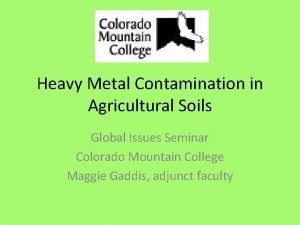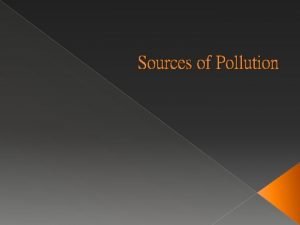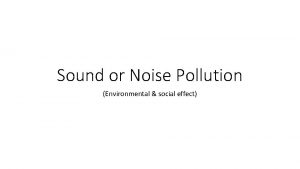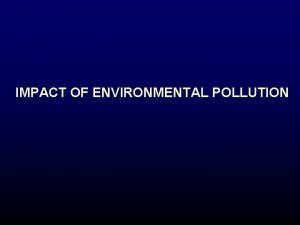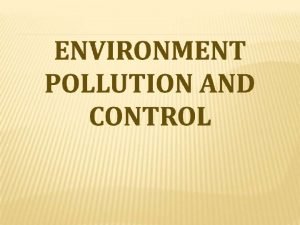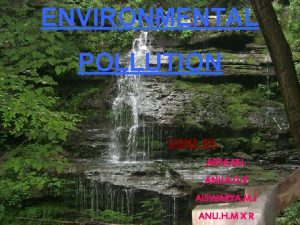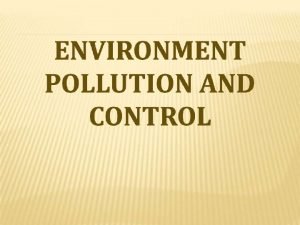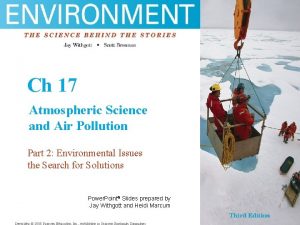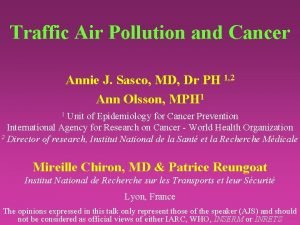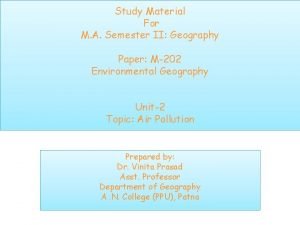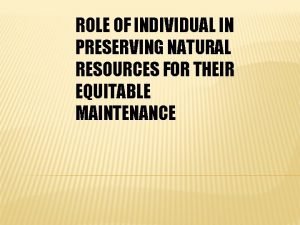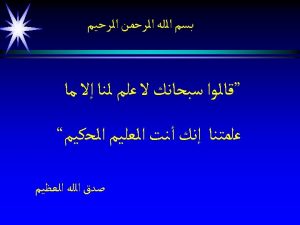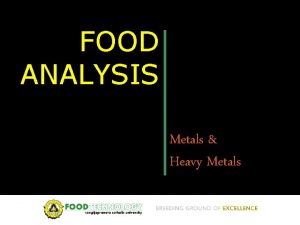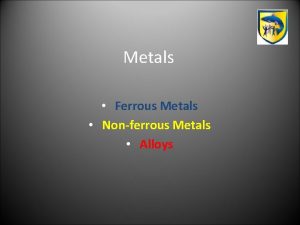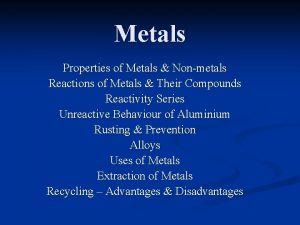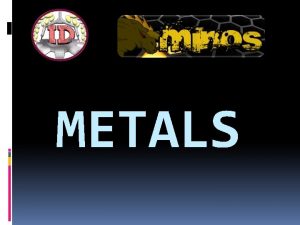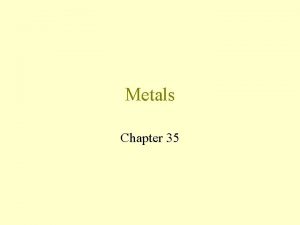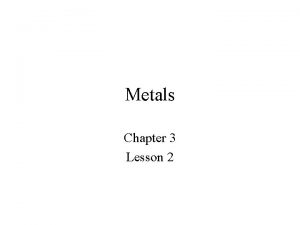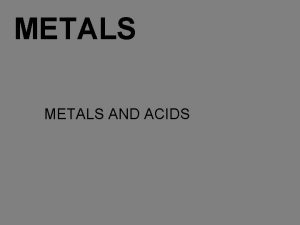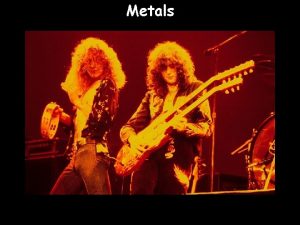Environmental Assessment Due to Heavy Metals Pollution from

























- Slides: 25


Environmental Assessment Due to Heavy Metals Pollution from Phosphate fertilizer Industry Supervised by Prof. Dr. M. A. Ghandour Prof. Dr. M. Abuel-Kassem Dr. Ahmed Kamal Prepared by Ch / Thabet Ali Mohamed

1 - Objectives of the study The study aims to: assess heavy metal pollution in soils in the adjoining area to the phosphate fertilizer plant and suggesting suitable solution for the present environmental impacts.

-Conducting researches on heavy metal pollution in soil is one of important issues worldwide. -Heavy metal do not go degradation, so they last many years in soil. -They affect microbial activity in soils, enzymes, prevent nutrients to be absorbed through plant rihzosphere zone. -They may leach from soil to deteriorate groundwater depending on soil layers. - they deplete soil quality by forming complexes with organic matter in soils.

Study area:

The phosphate fertilizer plant is located 9 km north of Assiut city with GPS (27 11 42 N , 31 7 11 E) built on about 20 sedans. The investigated area is lying downwind of the plant and much amounts of gases, fumes , vapours and particulates bearing heavy metals are deposited into soils of this area. The plant established 1978, till now there is no studies conducted to assess HMs and soil quality although impacts on plant , death of goats and sheep and visual signs of impaired environment.

Location and site description Fig. 1 : Geographical Map showing phosphate fertilizer location and the surrounding areas

Industrial Processes ØSSP ØTSP Ø Sulfuric acid production unit ØPhosphoric acid production unit

Characteristics of wastes by farming

Characteristics of wastes by farming

3 - Literature review ØJournals and periodicals ØEnvironmental sciences Ø Environmental Engineering ØEnvironmental Analysis ØEnvironmental pollution control

4 - Materials and Methods 4 -1 Experimental work § Air pollution ü Samples to detect Sox, NOx, H 2 S, HF, Si. HF 4, and PM 10 ü Samples of particulates to detect heavy metals ü Collecting Samples to detect Sox, NOx, H 2 S, HF, Si. HF 4, and PM 10 § Water pollution üCollecting samples from: 1 - Industrial waste water end-point 2 - Samples from Nile river. 3 - Samples from Al-ebrahymia canal. 4 - Samples from vertical tubes.

In water Samples the following parameters can be detected: üPH, NH 3, BOD, COD, TSS and TDS. ü detection of heavy metals such as Cd, Pb, Zn, Cu, As and Ni. § Soil Pollution üGeochemical testes for heavy metals that mentioned above. § Radio Activity üDetection of U-238, Ra-226 and K-40. § Meteorological measurements. ü Wind speed and direction, pressure, temperature and humidity

Locations of water and soil samples Fig. 2 : Geographical map represents the locations of water samples and soil samples positioned by GIS

4 -2 Devices and techniques 1 - ICP- AEM Fig. 3: ICP-MS unit

3 - Units for Evaluation and Testing Fig. 4: Evaluation of Minerals by XRD and XRF

4 - Evaluation of Samples by SEM & TEM Fig. 5: SEM & Tem units

5 - Air pollution monitors Fig. 6: Gas analyzer

5 - Discussion & Results ØEnvironmental Analysis of air samples ØEnvironmental Analysis of waste water samples ØEnvironmental Analysis of soil pollution.

Figure 7 (a) Example of SEM spectrum of a soil sample

Figure 7 (b) Example of SEM microstructure of the sample

Statistical Analysis Element Minimum Average Maximum Permissible Limit % Soil Samples Control Samples Soil Samples Control Sample Cd 0. 510 N. D 3. 990 0. 002 9. 01 0. 006 0. 00002 Pb 6. 270 0. 480 20. 745 0. 786 57. 65 1. 02 0. 02 " Zn 0. 080 0. 050 7. 044 0. 552 72. 58 1. 49 0. 03 " Hg 7. 570 1. 020 16. 593 1. 390 26. 92 2. 28 - " As 0. 540 N, D 5. 360 0. 002 18. 98 0. 007 0. 004 References Adriano. , 1986

Figure 8: Concentration of heavy metals compared with control and guideline values

Conclusion The phosphate fertilizer plant brings about serious heavy metal pollution problem. The soil is seriously polluted by heavy metals. The contents of Cd, Pb, Zn, Hg and As in soil reached a dangerous level where their concentration values surpassed those of the reference sample by significant values [10]. Cd and As are not detected in control sample and this refers that almost concentrations of the two elements do harm to the environment.

 Ratey rational functions
Ratey rational functions Periodic table metals and nonmetals
Periodic table metals and nonmetals Ferrous metals vs non ferrous metals
Ferrous metals vs non ferrous metals Metal vs nonmetal
Metal vs nonmetal Matter in natural science
Matter in natural science Grade 7 ns term 2
Grade 7 ns term 2 Non metal examples
Non metal examples Heavy metal pollution
Heavy metal pollution Objectives of environmental pollution
Objectives of environmental pollution Noise pollution conclusion
Noise pollution conclusion Meaning of environmental pollution
Meaning of environmental pollution Land pollution
Land pollution Aims and objectives of pollution
Aims and objectives of pollution Environmental pollution
Environmental pollution Environmental pollution
Environmental pollution Environmental pollution conclusion
Environmental pollution conclusion Meaning of environmental pollution
Meaning of environmental pollution Environmental pollution conclusion
Environmental pollution conclusion Figura geometrica con lati disuguali
Figura geometrica con lati disuguali Substantive vs procedural due process
Substantive vs procedural due process Nascita di sparta
Nascita di sparta Due piccole sfere identiche sono sospese
Due piccole sfere identiche sono sospese Chapter 7 ionic compounds and metals assessment answer key
Chapter 7 ionic compounds and metals assessment answer key Ionic compounds
Ionic compounds 7 ionic and metallic bonding practice problems
7 ionic and metallic bonding practice problems Wireless health
Wireless health







